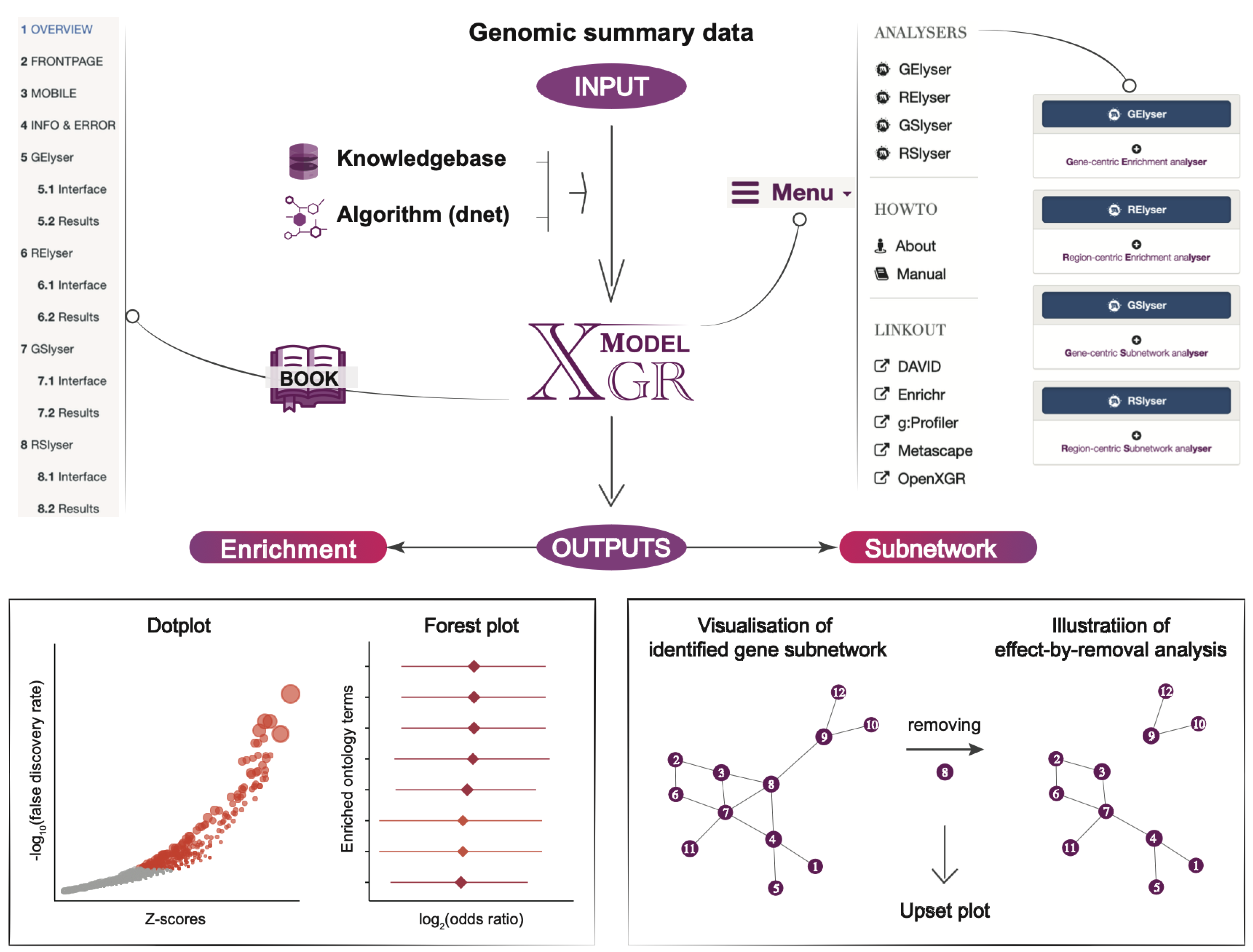XGRm Manual
2024-06-01
Section 1 OVERVIEW

FIGURE 1.1: Overview of how the XGRm web server works.
Motivation
We are very pleased to introduce a model organism version of our XGR software, which has gained increasing popularity in genomic summary data interpretation since its first release (see Genome Medicine 2016). This version features a newly designed web server, called XGRm, now made available here to all users for free and without any login requirements. It enables almost real-time enrichment and subnetwork analyses for a user-input list of genes or genomic regions, leveraging ontologies, networks, and knowledgebase resources about enhancer-promoter datasets. Besides, the web server is user-friendly, very suitable for users who are unfamiliar with coding.
One of the major challenges in genomics research is how to bridge the gap between generated genomic summary data and downstream knowledge discovery. We define genomic summary data as a list of genes (more generally, genomic regions), along with their significance levels (e.g. p-values). We are leading the field in making sense of genomic summary data for knowledge discovery through developing approaches and tools that have been verified to be efficient and effective, including dnet (see Genome Medicine 2014), Priority index (see Nature Genetics 2019 and Nucleic Acids Research 2022), and XGR/OpenXGR (see Genome Medicine 2016 and Nucleic Acids Research 2023).
Building upon our previous approaches that have stood the test of time, and also incorporating the growing knowledgebase of ontologies and networks, XGRm offers four analysers for enrichment and subnetwork analyses, each doing specific interpretations tailored to genomic summary data at the gene and genomic region levels.
Analysers
| Type | Description | Entities | |
|---|---|---|---|
| GElyser | Enrichment | Gene-centric enrichment analyser | Genes |
| RElyser | Enrichment | Region-centric enrichment analyser | Regions |
| GSlyser | Subnetwork | Gene-centric subnetwork analyser | Genes |
| RSlyser | Subnetwork | Region-centric subnetwork analyser | Regions |
GElyser performs gene-centric ontology enrichment analysis. See Example Output
RElyser first identifies genes linked from input genomic regions using either genomic proximity or enhancer-gene maps. It then conducts ontology enrichment analysis based on the linked genes. See Example Output
GSlyser takes gene-level summary data (i.e., a list of genes and their p-values) as input to identify a subset of the gene network. The resulting subnetwork contains a desired number of highly scored and interconnected genes, followed by subnetwork-based effect-by-removal analysis. See Example Output
RSlyser first identifies genes linked to input genomic regions using either genomic proximity or enhancer-gene maps. Based on the linked genes, it subsequently performs subnetwork analysis and concludes with subnetwork-based effect-by-removal analysis. See Example Output
Browser compatibility
| MacOS (Big Sur) | Windows (10) | Linux (Ubuntu) | |
|---|---|---|---|
| Safari | 15.6.1 | N/A | N/A |
| Edge | N/A | 108.0.1462.54 | N/A |
| Chrome | 108.0.5359.124 | 108.0.5359.124 | 108.0.5359.124 |
| Firefox | 108.0.1 | 108.0.1 | 108.0.1 |
Runtime
| Analysers | Description | Runtime |
|---|---|---|
| GElyser | Gene-centric Enrichment analyser | ~5 seconds |
| RElyser | Region-centric Enrichment analyser | ~20 seconds |
| GSlyser | Gene-centric Subnetwork analyser | ~5 seconds |
| RSlyser | Region-centric Subnetwork analyser | ~25 seconds |
Knowledgebase
| Category | Description | Analysers | |
|---|---|---|---|
| GOBP | Functions | Gene Ontology Biological Process | GElyser, RElyser |
| GOMF | Functions | Gene Ontology Molecular Function | GElyser, RElyser |
| GOCC | Functions | Gene Ontology Cellular Component | GElyser, RElyser |
| KEGG | Pathways | KEGG pathways | GElyser, RElyser |
| MONDO | Phenotypes | MONDO Disease Ontology | GElyser, RElyser |
| MPO | Phenotypes | Mammalian Phenotype Ontology | GElyser, RElyser |
| STRING | Functions | Functional interaction networks | GSlyser, RSlyser |
| KEGG | Pathways | Pathway interaction networks | GSlyser, RSlyser |